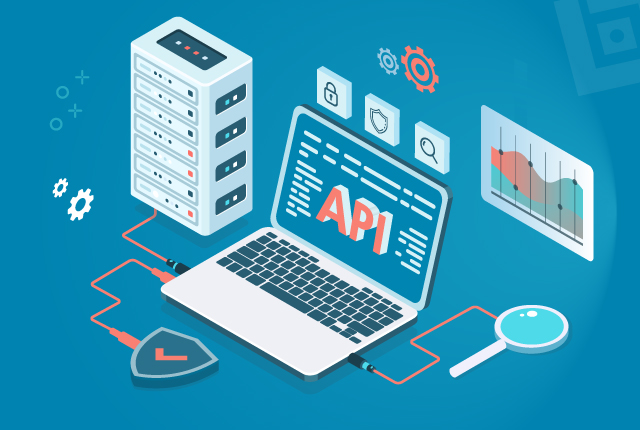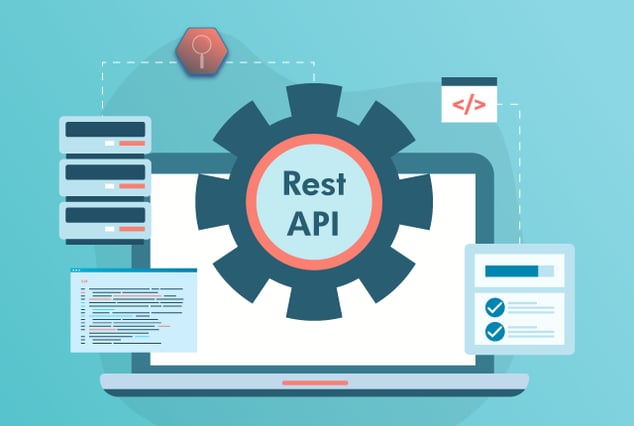
Table of Contents
- What is API integration testing?
- Why is API integration testing important?
- What are the types of API integration testing?
- How to perform API integration testing?
- What are the challenges of API integration testing?
- QASource’s Best practices for API integration testing
- Best tools for API integration testing
- Latest AI trends in API integration testing in 2025
- Final thought
APIs (Application Programming Interfaces) help different software systems work together by sharing data and functions. But if these APIs don’t work properly, systems can fail, causing errors and security issues. API integration testing makes sure APIs communicate smoothly and perform as expected. This testing checks how well APIs handle data, security, performance, and errors. In this guide, you’ll learn what API integration testing is and how artificial intelligence (AI) makes API testing smarter and faster.
What is API Integration Testing?
An API allows different software applications to connect and communicate with each other. It acts as a bridge between systems, helping them exchange data and perform tasks smoothly. For example, when you use TripAdvisor to compare hotel prices, the app gathers data from multiple hotel and airline APIs to show you the best options.
API integration involves connecting different applications and systems to work together automatically. It helps businesses automate workflows, share data, and improve efficiency.
However, when an API is exposed to users, it becomes a product. It can disrupt one feature and the entire business process if it fails. That’s why API integration testing is essential. It ensures that APIs work correctly, handle data properly, and interact smoothly with other systems.
Today, APIs are a core part of how modern businesses operate. The focus isn’t just on creating APIs and testing and monitoring them to ensure they function reliably and securely.
Why Is API Integration Testing Important?
Here’s why API integration testing is critical:
-
Prevents Business Disruptions
A broken API can halt key business operations. For example, customers can't complete purchases if a payment API fails, leading to revenue loss. Testing helps avoid such disruptions.
-
Ensures Data Accuracy
APIs constantly exchange data between systems. Testing checks if data is correctly transferred and processed, reducing the risk of errors or data loss.
-
Improves Security
Hackers often target APIs. Testing helps in detecting security flaws, such as unauthorized access or data leaks, and protects sensitive information.
-
Supports Faster Development
Regular API testing identifies bugs early in the development process. Fixing problems early saves time and reduces costly fixes later.
-
Enhances User Experience
A well-tested API ensures smooth, reliable app performance. This keeps users satisfied and engaged.
-
Handles System Updates
APIs must stay compatible with system updates or third-party changes. Testing confirms that updates don’t break existing integrations.
What are the Types of API Integration Testing?
API integration testing covers different areas to ensure APIs work smoothly with other systems. Each type focuses on specific aspects of API behavior and performance. Here are the main types:
-
Functional Testing
- Verifies if the API performs its intended functions.
- Checks API responses, data processing, and workflows.
- Example: Testing if a payment API correctly processes transactions.
-
Load Testing
- Measures how the API performs under heavy user traffic.
- Identifies slow responses or failures under high demand.
- Example: Testing an e-commerce API during a sale event.
-
Security Testing
- Detects vulnerabilities in APIs.
- Checks authentication, authorization, and data protection.
- Example: Verifying if sensitive data is encrypted and access is controlled.
-
Error Handling Testing
- Tests how APIs handle invalid inputs or system failures.
- Ensures proper error messages and responses.
- Example: Check if an API returns the correct error when missing data.
-
Performance Testing
- Evaluate the speed, stability, and reliability of the API.
- Identifies performance bottlenecks.
- Example: Measuring response time when multiple APIs interact.
-
Regression Testing
- Ensures new updates don’t break existing features.
- Runs previous test cases after changes or upgrades.
- Example: Testing after adding a new feature to ensure existing ones still work.
-
Integration Testing
- Verifies how well the API integrates with other APIs, databases, and systems.
- Focuses on data flow and system communication.
- Example: Testing if a hotel booking API correctly pulls data from airline APIs.
-
User Interface (UI) Testing
- Ensures APIs deliver correct data to the user interface.
- Useful for apps where APIs power user-facing features.
- Example: Testing if weather data from an API displays correctly on a weather app.
How to Perform API Integration Testing?
Here’s a step-by-step guide to performing effective API integration testing:
-
Understand API Requirements
- Review API documentation to understand its functions, endpoints, request methods (GET, POST, PUT, DELETE), and data formats.
- Identify the expected inputs, outputs, and possible error responses.
-
Set Up the Testing Environment
- Configure the environment where testing will occur (development, staging, or production).
- Set up the necessary servers, databases, and tools.
-
Define Test Cases
- Create test cases for different API scenarios, including:
- Valid and invalid inputs
- Expected responses
- Error handling
- Security checks
- Include edge cases to check how the API handles unexpected inputs.
- Create test cases for different API scenarios, including:
-
Choose the Right Testing Tools
- To automate and simplify testing, select API testing tools like Postman, SoapUI, Swagger, JMeter, or Rest Assured.
-
Run Different Types of Tests
- Functional Testing: Verify the API functions as expected.
- Load Testing: Check how the API performs under stress.
- Security Testing: Identify vulnerabilities and data protection issues.
- Integration Testing: Confirm the API works well with other systems.
-
Validate Responses
- Check the API’s response code (e.g., 200 for success, 404 for not found, 500 for server error).
- Verify the accuracy of response data, response time, and data format (JSON, XML).
-
Test Error Handling
- Input invalid data to check if the API returns appropriate error messages.
- Simulate system failures to see how the API reacts.
-
Automate Testing (If Needed)
- Use automation tools for repetitive tests to save time and reduce manual errors.
- Run automated tests regularly, especially after updates.
-
Monitor and Analyze Results
- Review test results to identify bugs, performance issues, or security flaws.
- Fix detected issues and retest to confirm the fix works.
-
Document the Testing Process
- Record test cases, results, bugs, and fixes.
- Maintain clear documentation for future reference and audits.
What are the Challenges of API Integration Testing?
API integration testing is essential for delivering reliable and secure software, but several challenges can slow development and affect product quality. Here’s a detailed look at these challenges:
-
Lack of Proper API Documentation
Poor or outdated documentation makes it hard for testers to understand API functions, leading to incomplete or incorrect test cases and missed bugs.
-
Handling Complex Integrations
Modern systems use multiple APIs, making it challenging to manage interactions and dependencies. A failure in one API can disrupt the entire workflow.
-
Data Dependency Issues
APIs rely on specific data to function. Inconsistent or missing test data can cause failed tests and incomplete coverage.
-
Managing Different API Versions
Frequent API updates create multiple versions. Testing across versions is complex, risking compatibility issues for users on older versions.
-
Error Handling Validation
APIs often lack proper error responses. Poor error handling can lead to security risks and confusing user experiences.
-
Security and Authentication Complexity
APIs require secure authentication (OAuth, API keys). Testing these layers without exposing sensitive data is complex but necessary to prevent security breaches.
-
Performance and Load Testing
Simulating real-world traffic is hard. APIs may crash or slow down under heavy use without proper load testing.
-
Third-Party API Dependency
APIs often depend on external services. Limited access, rate limits, or downtime in third-party APIs make testing unreliable.
-
Test Environment Setup
Setting up a production-like environment is costly and time-consuming. Misconfigurations can lead to inaccurate results.
QASource’s Best Practices for API Integration Testing
Here are our key strategies to improve testing effectiveness:
-
Understand API Requirements Thoroughly
Before testing, QASource reviews API documentation to understand endpoints, request methods, parameters, and expected responses. This ensures that test cases cover all functions and edge cases.
-
Use Realistic and Consistent Test Data
We create accurate and consistent test data that mimics real-world scenarios. This helps validate how APIs handle different data inputs and outputs, reducing false results.
-
Automate Repetitive Tests
Our engineers automate routine tests using Postman, Rest Assured, and SoapUI tools. Automation improves test efficiency, expands coverage, and accelerates bug detection.
-
Test for Different Scenarios
We ensure APIs handle all situations by testing positive (valid inputs), negative (invalid inputs), and edge cases. We also test error handling to verify API resilience.
-
Prioritize Security Testing
Test authentication, authorization, and data encryption to protect against threats. Simulate attacks like SQL injection or unauthorized access to uncover security gaps.
-
Validate Performance Under Load
We perform load and performance testing using tools like JMeter and LoadRunner to identify bottlenecks and ensure APIs can handle peak traffic efficiently.
-
Test API Version Compatibility
Ensure that API updates don’t break existing features. Perform regression testing to confirm that older versions still function correctly after changes.
-
Monitor API Behavior in Real-Time
Monitoring tools track API performance and detect issues in real time. Continuous monitoring helps prevent downtime and performance issues.
-
Ensure Proper Error Handling
Test how the API manages errors and failures. APIs should return clear, helpful error messages and gracefully handle unexpected inputs.
-
Maintain Clear Documentation
We maintain up-to-date API documentation that reflects endpoints, parameters, and responses changes. This supports effective collaboration between testers, developers, and stakeholders.
Best Tools for API Integration Testing
Here are some of the best tools for testing APIs:
-
Postman
- Use Case: Functional and automated API testing
- Features: Easy-to-use interface, automated test scripts, API monitoring, and collaboration tools
- Best For: Beginners and teams needing quick setup for RESTful API testing
-
SoapUI
- Use Case: Functional, security, and performance testing of APIs
- Features: Supports REST and SOAP APIs, drag-and-drop interface, and data-driven testing
- Best For: Enterprise-level testing with complex APIs
-
Rest Assured
- Use Case: Java-based automated API testing
- Features: Simplifies testing of REST services, integrates with testing frameworks like JUnit and TestNG
- Best For: Developers who prefer writing code-driven tests
-
JMeter
- Use Case: Load and performance testing
- Features: Simulates heavy traffic, supports REST and SOAP APIs, extensive plugin support
- Best For: Testing API performance under high loads
-
Katalon Studio
- Use Case: End-to-end and automated API testing
- Features: Supports REST, SOAP, and GraphQL APIs, built-in reports, CI/CD integration
- Best For: Testers looking for a no-code/low-code solution
-
Swagger (OpenAPI)
- Use Case: API design, documentation, and testing
- Features: Auto-generates documentation, interactive API testing, supports API mocking
- Best For: Developers needing well-documented APIs and testing
-
Apigee
- Use Case: API testing, monitoring, and management
- Features: API security, analytics, and traffic management tools
- Best For: Enterprises managing large-scale APIs
-
Karate DSL
- Use Case: API automation testing
- Features: Combines API testing with performance and UI testing, supports JSON and XML validation
- Best For: Teams needing unified testing solutions
-
Pytest (with Requests)
- Use Case: Python-based API testing
- Features: Flexible test creation with Python, integration with CI/CD pipelines
- Best For: Developers using Python for automated testing
-
Insomnia
- Use Case: RESTful API testing and debugging
- Features: Intuitive UI, supports GraphQL, environment variables, and plugins
- Best For: Developers needing lightweight and quick API testing
Latest AI Trends in API Integration Testing in 2025
Artificial Intelligence (AI) is revolutionizing API integration testing by making it smarter, faster, and more efficient. IAI-driven solutions are helping teams overcome common testing challenges and improve overall software quality. Here are the latest AI trends in API integration testing:
-
AI-Driven Test Generation
AI can automatically analyze API specifications and user behavior to create test cases. This reduces manual work, increases test coverage, and ensures that even complex scenarios are tested thoroughly.
-
Predictive Analytics for Testing
AI uses predictive models to detect potential bugs and performance issues before they happen. This proactive approach helps teams fix problems early, improving API reliability and performance.
-
Intelligent Automation
AI automates repetitive and complex testing tasks like regression testing and performance monitoring. This streamlines testing workflows and allows teams to focus on more strategic work.
-
Enhanced Security Testing
AI-powered tools can identify security vulnerabilities and simulate cyberattacks to test how APIs handle threats. This strengthens API security and reduces the risk of data breaches.
-
Integration with DevOps Practices
AI seamlessly integrates with DevOps pipelines, enabling continuous testing and faster deployment cycles. This ensures APIs are tested thoroughly at every stage of development, supporting agile delivery.
Final Thought
API integration testing is vital for building reliable, secure, high-performing software systems. As APIs become more complex and central to business operations, ensuring seamless functionality is more important than ever. AI transforms how APIs are tested, making the process smarter and more adaptive to modern development needs. Prioritizing API integration testing prevents system failures, strengthens security, improves user experiences, and supports business growth.



